Insights
Getting started with a WhatsApp chatbot: A no-code business guide
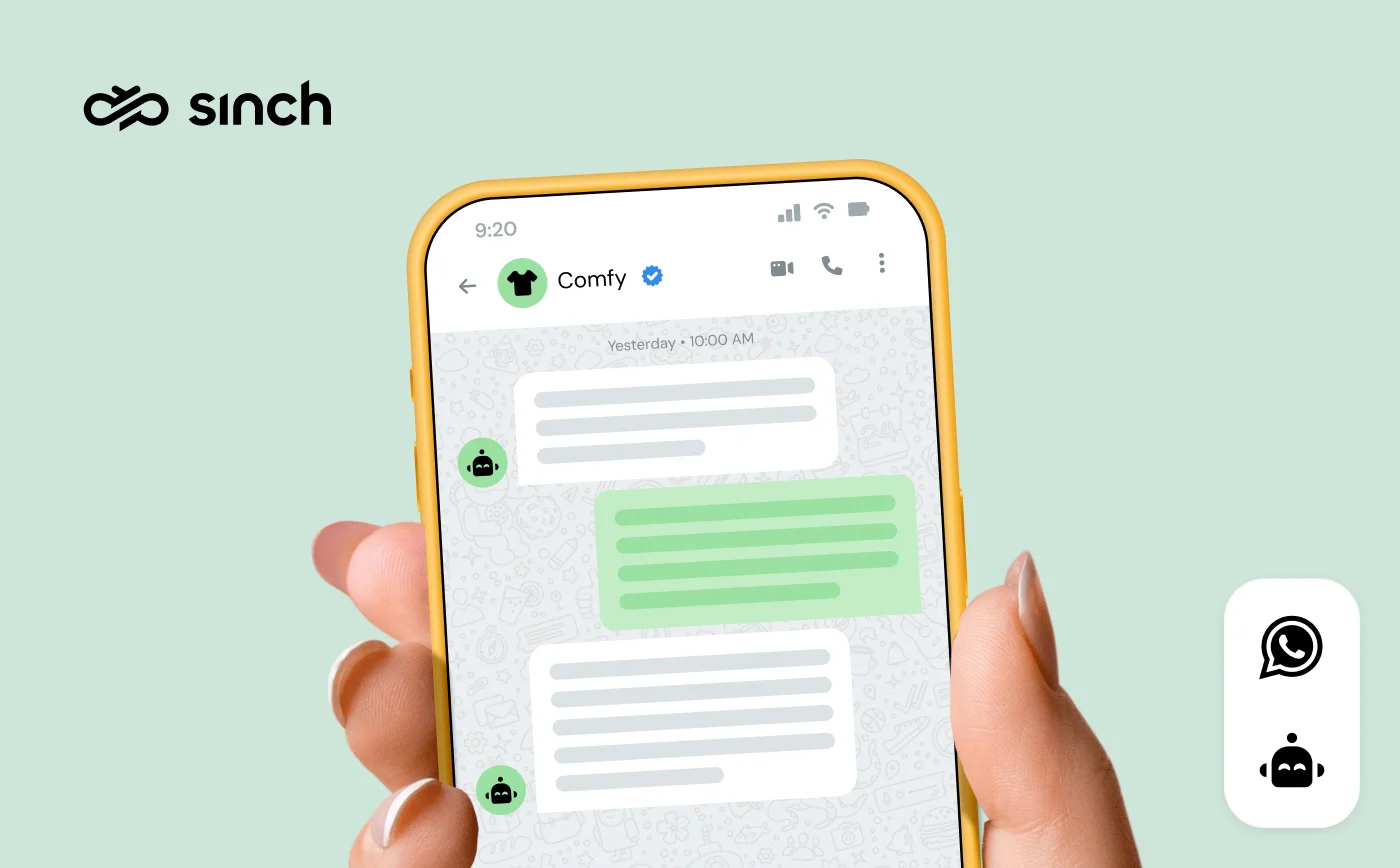
Insights

WhatsApp bots allow you to scale marketing campaigns, automate repetitive conversations, and assure 24/7 availability – all without expanding your team. In this guide, we look at what a WhatsApp bot can do for your business and how you can get started with one.
You’re drowning in customer messages and wondering if WhatsApp bots can actually handle high-volume support without making things worse.
While 175 million people message businesses on WhatsApp daily, a lot of companies still rely on manual responses, and it’s a serious struggle to keep up with ever-increasing message demands.
Our State of customer communications report shows, though, that 42% of consumers are open to working with AI that’s trained on support documentation. We also found that more than half of retailers are at least experimenting with chatbots and other industries are looking at investing in automation this year.
Sounds good, but not quite sure how to go about it? No worries!
This guide walks through what WhatsApp bots can do for customer service and marketing, real examples from companies handling thousands of conversations, and how to build one without writing code.
A WhatsApp chatbot is a virtual (AI) assistant that automates customer interactions through the WhatsApp Business Platform, more commonly known as WhatsApp Business API. These bots handle everything from answering common questions to processing orders – helping you scale your customer communication without adding staff.
WhatsApp supports different types of bots:
Important: You can only integrate chatbots on WhatsApp if you use the WhatsApp Business Platform (API). Chatbots don’t work with the free WhatsApp Business app. You get access to the API through verified Business Solution Providers like Sinch.
The type of bot you choose depends on what your customers need and how complex your setup is. Menu bots are great for simple, clear-cut tasks. AI bots are better when customers ask a wide range of questions. Many larger companies start with menu bots and then add AI features over time as their needs grow.
WhatsApp is the world’s most popular messaging app, with three billion people using it globally. That massive user base gives businesses a direct line to customers wherever they are.
The data businesses report from their WhatsApp usage speaks for itself.
message open rates
reduction in customer churn
Conversion rates
increase in efficiency when using WhatsApp bots
The numbers show why your company can’t afford to ignore WhatsApp. A huge audience is engaged, and they expect to be able to communicate with you quickly and clearly. That’s probably exactly why you’re already using WhatsApp.
WhatsApp bots make this connection even more powerful. They handle repetitive questions automatically while still feeling personal to customers. And in case you’re wondering, consumers are very open to chat-based support. In fact, Sinch data shows that 73% of shoppers prefer live chat over email or phone support.
It makes sense since many support questions can be handled immediately by a bot. Let’s say that someone sends a message asking about store hours or order status, then the WhatsApp chatbot responds instantly instead of making them wait in a customer support queue. This frees up your human agents to tackle the tricky problems that need a person’s help – like troubleshooting a failed payment or helping someone reschedule a delivery across time zones.
Let’s look at a few use cases to illustrate how a WhatsApp bot can work in practice.
Before jumping in, it’s important to be thoughtful about what you delegate to a WhatsApp chatbot. Not every task is a fit for automation – some need a human touch. But for repetitive, high-volume interactions, bots can create value by speeding up response times and freeing up your team to focus on more complex issues.
We recommend to always offer users an option to leave the chatbot conversation and contact a human agent.
Here are five use cases to consider automating:
FAQ automation is the most common starting point for businesses that handle large message volumes on WhatsApp. Whether using simple menu-driven responses or advanced conversational AI, bots can instantly address the questions that make up 60 to 80% of typical customer service volume.
Menu bots work well for straightforward questions with predictable answers: store hours, return policies, shipping costs, or account balance inquiries. Conversational AI bots, on the other hand, are better fit to handle more complex scenarios where customers phrase questions differently or need follow-up clarification.
Brazil’s leading food delivery platform iFood, for example, uses WhatsApp chatbots to tackle overwhelming support volumes from drivers, restaurants, and customers. Their conversational AI solution automates restaurant onboarding, handles driver support requests, and manages customer inquiries across multiple touchpoints.
But iFood also uses a more conversational bot for guiding customers through the process of buying an electronic gift card. This is a good example of starting with one basic chatbot use case and then expanding based on results and demand.
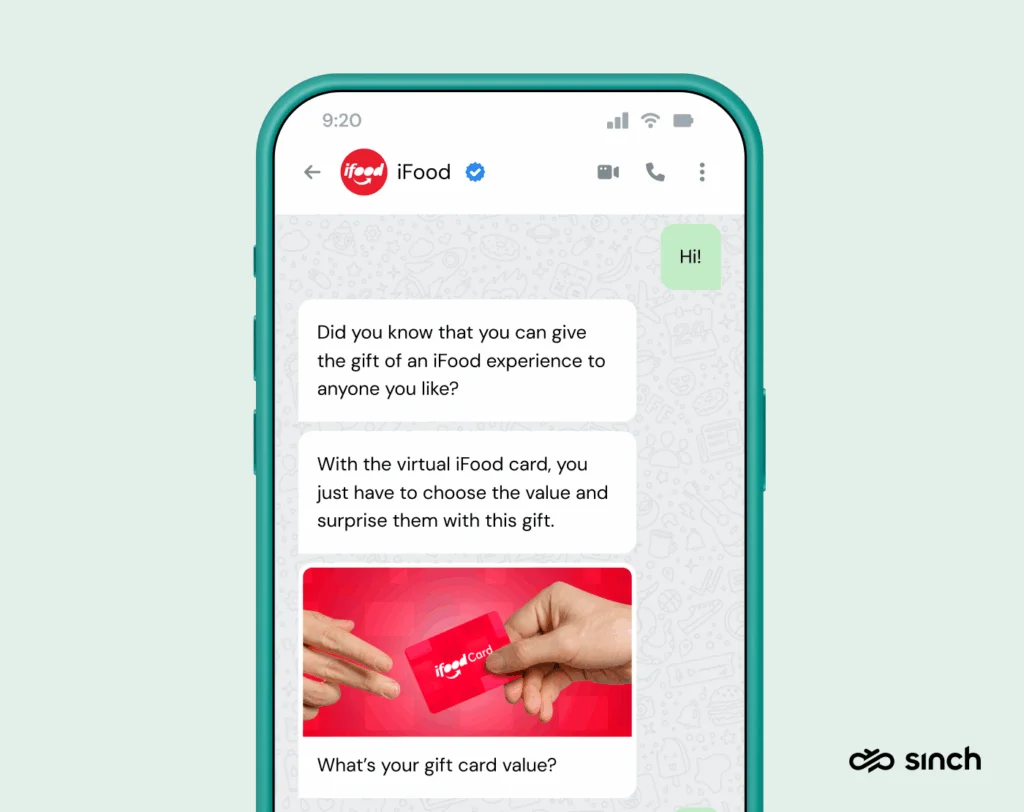
With this approach, iFood automated 94% of its support tickets, reduced delivery service costs by 70%, and raised customer satisfaction to 91%. The bot handles 45% of all incoming inquiries which reduces the volume that human agents handle manually.
Transactional WhatsApp messages like order confirmations, tracking information, or account updates provide real-time visibility across touchpoints while reducing service load. You can easily automate these with a WhatsApp bot.
Unlike promotional messages, transactional updates don’t require opt-in permissions. Bots can send these messages based on triggers from your order management or CRM systems.
Common automated updates include:
These messages reduce customer anxiety about order status while decreasing “Where is my order?” support tickets that consume agent time.
WhatsApp bots can function as 24-hour personal assistants that go beyond simple FAQ responses. They can guide users through situations that need extra attention, provide personalized recommendations, and even offer inspiration based on customer preferences and behavior.
For example, Bangalore’s third-largest shopping mall created “Orion Genie,” a WhatsApp chatbot that acts as a personal shopping assistant accessible via WhatsApp. Customers can jump straight into the chat by scanning QR codes around the mall or on social media to start conversations about store hours, dining options, current promotions, and entertainment schedules.
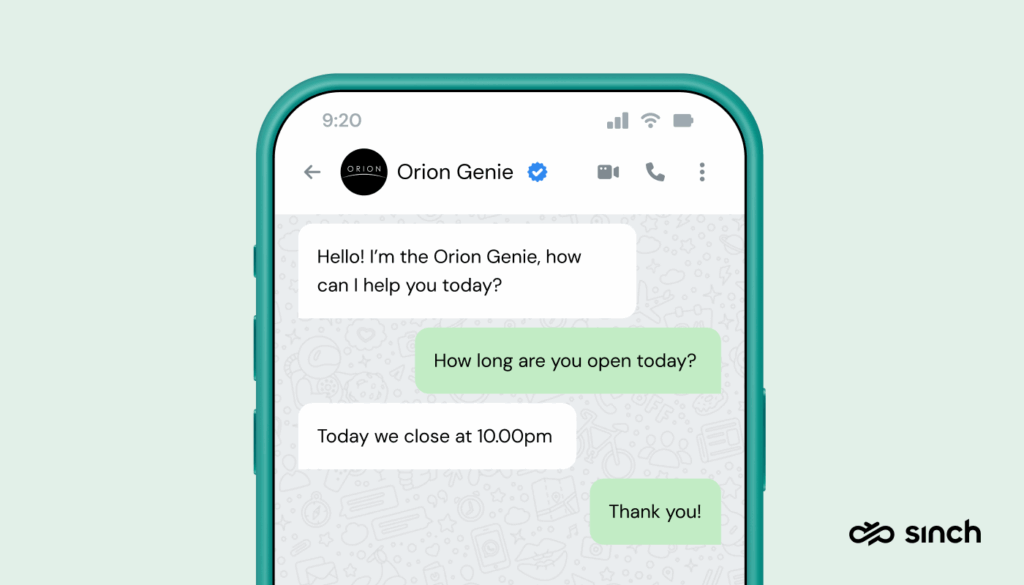
But Genie also helps customers plan entire day trips by suggesting activities based on their interests, provides real-time updates about events, and guides visitors to specific stores or restaurants. The bot handles 3,500 conversations monthly with over 2,000 active users.
As a result, Orion Mall has seen significant increases in foot traffic and revenue as customers felt more informed and confident about planning visits. The bot’s ability to provide instant, personalized guidance encouraged more people to explore and buy.
With WhatsApp’s automation flow feature, WhatsApp Flows, companies can completely automate processes like RSVPing for events, booking tickets, placing orders, and making reservations.
These flows keep customers within WhatsApp throughout the entire process, eliminating the need for popup redirects or external forms.
Brazil’s financial service enterprise Consórcio Magalu faced a 92% abandonment rate when customers were redirected from WhatsApp to external booking sites. They solved this by implementing WhatsApp Flows for their appointment scheduling system.
The new process keeps everything within WhatsApp. Customers receive loan information, tap “Book now,” then use WhatsApp Flows to select dates, times, and appointment types (in-person, video, or phone) without leaving the WhatsApp chat.
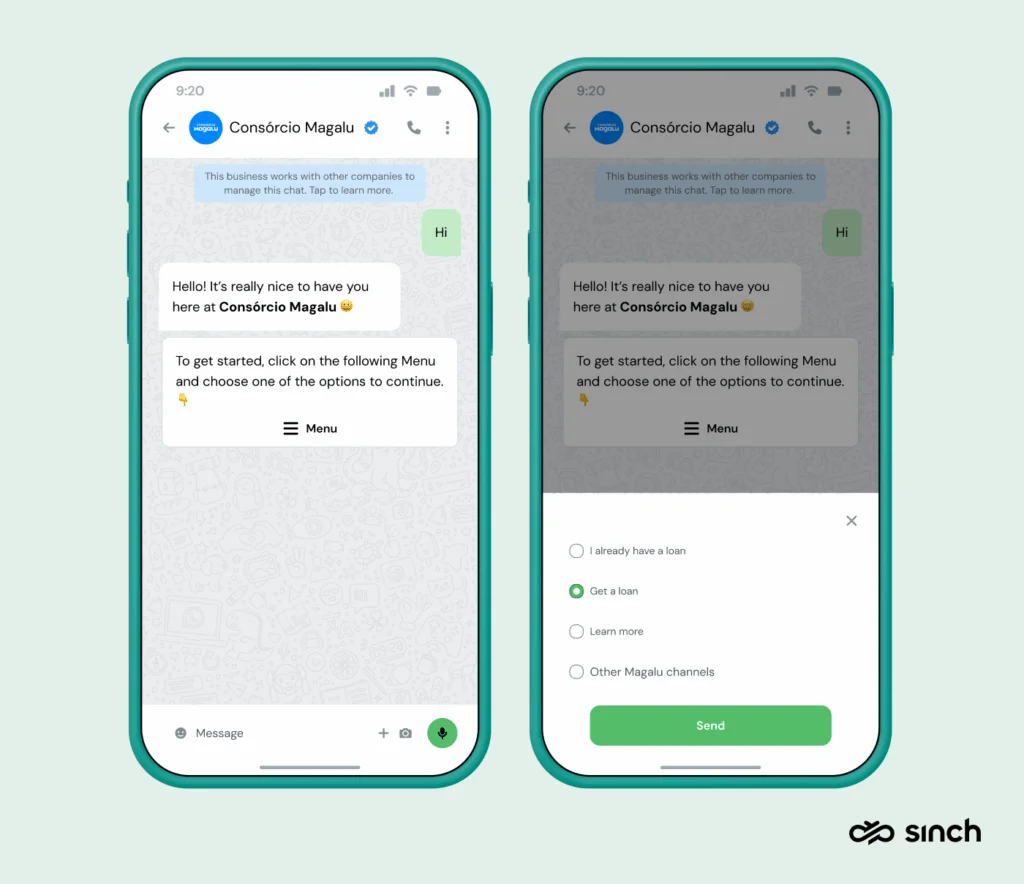
Conversions from organic visitors nearly tripled, paid traffic led to 49% more purchases, and customer satisfaction went up by 21%. By letting people book without switching apps, they turned a clunky, frustrating process into something quick and easy to finish.
If your customer base uses WhatsApp, the end-to-end encrypted messaging app offers a secure way to send one-time passwords for account verification, login authentication, and transaction confirmations.
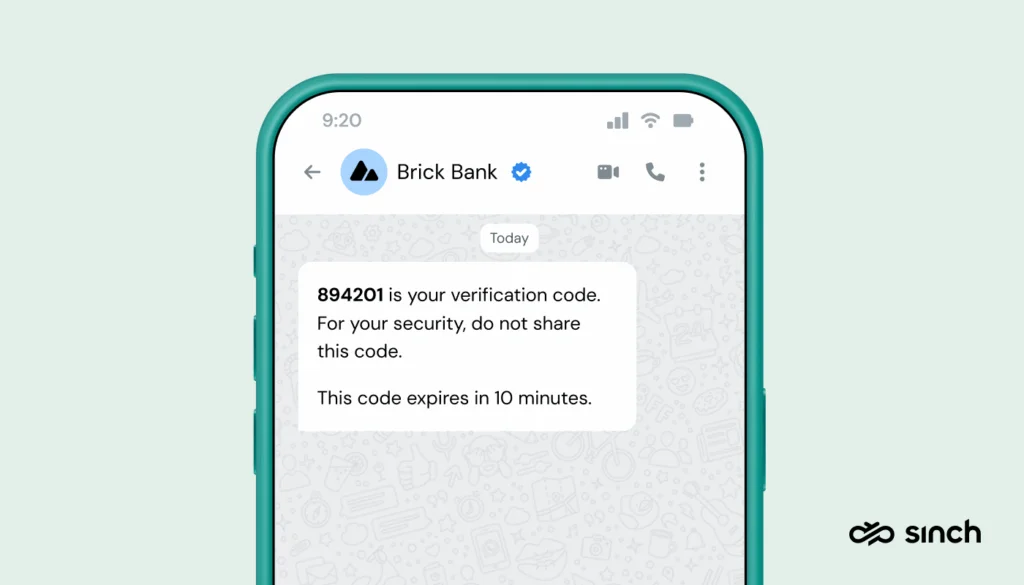
WhatsApp’s encryption provides an additional layer of security compared to standard SMS, making it ideal for financial services, healthcare, and e-commerce platforms that handle sensitive customer data. OTPs arrive instantly, so customers can act on verification codes quickly.
Banks, payment apps, and online services increasingly use WhatsApp OTPs because customers trust the platform and already have it installed. The familiar interface reduces friction in authentication processes while maintaining enterprise-grade security standards.
As you can see, WhatsApp bots can be a helpful tool for many marketing and customer support use cases. But, how do you set one up? The good news is: With the right WhatsApp Business solution, you don’t need programming skills to get started.
As mentioned, you can only integrate a chatbot on WhatsApp if you’re using the WhatsApp Business API. That’s where a verified WhatsApp Business Solution Provider (BSP) like Sinch comes in because BSPs provide businesses access to the API.
Once you have set up your business profile in the API, you can start the bot integration. The exact process depends on your provider’s platform and setup.
With Sinch, setting up your WhatsApp bot is quick and straightforward using our no-code Chatlayer chatbot builder with drag-and-drop functionality.
Here’s a step-by-step tutorial on how to set it up:
All channels linked to your Sinch Conversation API will sync automatically with Chatlayer.
Read our documentation for detailed setup instructions.
To speed things up, Sinch also offers pre-built chatbot templates. And if you’re looking to extend your automation strategy across other messaging channels? You can easily expand your chatbot to Facebook Messenger, Telegram, Viber, and more.
This makes it really easy to build your first WhatsApp chatbot.
Need help getting started? Reach out to our team – we’re happy to walk you through the setup and discuss pricing options.